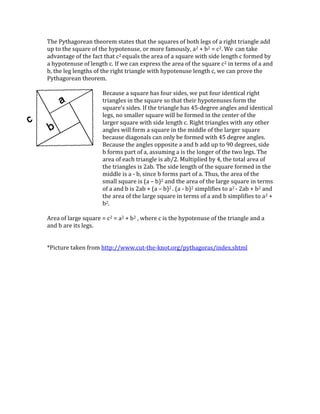
Pythagorean Theorem Explained: How Squares on the Legs Equal the Hypotenuse Square
- 1. The Pythagorean theorem states that the squares of both legs of a right triangle add up to the square of the hypotenuse, or more famously, a2 + b2 = c2. We can take advantage of the fact that c2 equals the area of a square with side length c formed by a hypotenuse of length c. If we can express the area of the square c2 in terms of a and b, the leg lengths of the right triangle with hypotenuse length c, we can prove the Pythagorean theorem. Because a square has four sides, we put four identical right triangles in the square so that their hypotenuses form the square’s sides. If the triangle has 45-degree angles and identical legs, no smaller square will be formed in the center of the larger square with side length c. Right triangles with any other angles will form a square in the middle of the larger square because diagonals can only be formed with 45 degree angles. Because the angles opposite a and b add up to 90 degrees, side b forms part of a, assuming a is the longer of the two legs. The area of each triangle is ab/2. Multiplied by 4, the total area of the triangles is 2ab. The side length of the square formed in the middle is a - b, since b forms part of a. Thus, the area of the small square is (a – b)2 and the area of the large square in terms of a and b is 2ab + (a – b)2 . (a - b)2 simplifies to a2 - 2ab + b2 and the area of the large square in terms of a and b simplifies to a2 + b2. Area of large square = c2 = a2 + b2 , where c is the hypotenuse of the triangle and a and b are its legs. *Picture taken from http://www.cut-the-knot.org/pythagoras/index.shtml